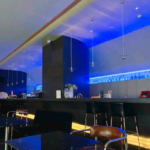Huishan Temple is a scenic spot in Xihui Park, Wuxi. To the west of Xihui Park is the scenic area at the foot of Huishan Mountain. To the east is the leisure area that includes Xishan Mountain. Huishan Temple belongs to the scenic area and is located in the north of this area. The temple was first built in the Northern and Southern Dynasties. It has been destroyed and rebuilt many times in successive dynasties, so ancient relics of various dynasties have been left behind.
Li Shen of the Tang Dynasty once wrote the famous poem “Sympathy for Farmers” here. The verse “At noon farmers weed with hoes; Their sweat drips on the soil beneath.” is widely known. Coming to Huishan Temple is for seeking ancient relics on the one hand and praying for blessings on the other. The main buildings of Huishan Temple are arranged along the central axis running from east to west. The first mountain gate is opened in the east and is called Ancient Huashan Gate. Behind the mountain gate stand two stone sutra pillars. One is from the Tang Dynasty and the other is from the Song Dynasty. Ahead is the second mountain gate in the shape of a two-story attic, namely the Vajra Hall. On the first floor hangs the plaque of “Huishan Temple”, and on the second floor hangs the plaque of “The First Mountain in Jiangnan”. Inside the hall are enshrined the two generals Heng and Ha. Further ahead is the Heavenly King Hall with three arches, where the Four Heavenly Kings are enshrined. Passing through the Heavenly King Hall, one arrives at the essence of the entire temple. In a courtyard, the ancient stone bridge in Wuxi, the Golden Lotus Bridge of the Song Dynasty, is laid out in front. The two sides of the bridge are engraved with beautiful patterns. In summer, the lotus in the pond under the bridge blooms and is extremely charming. For the need of cultural relic protection, people cannot walk on the bridge. Opposite the bridge is the stele pavilion of Emperor Qianlong. Circling from beside the bridge to the center of the courtyard, the ginkgo tree of Hongwu in the Ming Dynasty has towering branches and leaves. It is good to come to appreciate the ginkgo in autumn. The golden leaves cover the ground. Under the ginkgo tree is a stone bed for listening to the pine in the Tang Dynasty. Li Yangbing, a calligrapher of the Tang Dynasty, wrote the two characters “Listening to the Pine” in seal script on the stone bed. On one side of the courtyard, there is also a newly-built bell pavilion in modern times, with a Tang-style bronze bell inside. Behind the Datong Hall in the courtyard, only the gate tower can be seen but not the hall. Passing through the gate is the main hall, the Mahavira Hall, where Sakyamuni, Manjusri, and Samantabhadra are enshrined. Buildings not on the central axis of the temple include the Great Compassion Pavilion where the Thousand-Handed Avalokitesvara is enshrined, the Sutra Depository Building (Bayeux scented), etc. Standing in the Great Compassion Pavilion and looking east, one can see the Longguang Pagoda, one of the landmarks of Wuxi on Xishan Mountain. Walking south from Huishan Temple, one can reach the Second Best Spring Under Heaven. The Golden Lotus Bridge leads north to Jichang Garden. On December 31 every year, Huishan Temple will hold bell-ringing activities to welcome the new year. Dharma assemblies will also be held on the birthdays of various bodhisattvas and important Buddhist festivals. Opening hours: Open all year round from 08:00 to 17:00. The specific business status is subject to the opening situation on that day.Huishan Temple
Huishan Temple is a scenic spot in Xihui Park, Wuxi. To the west of Xihui Park is the scenic area [&[...]









